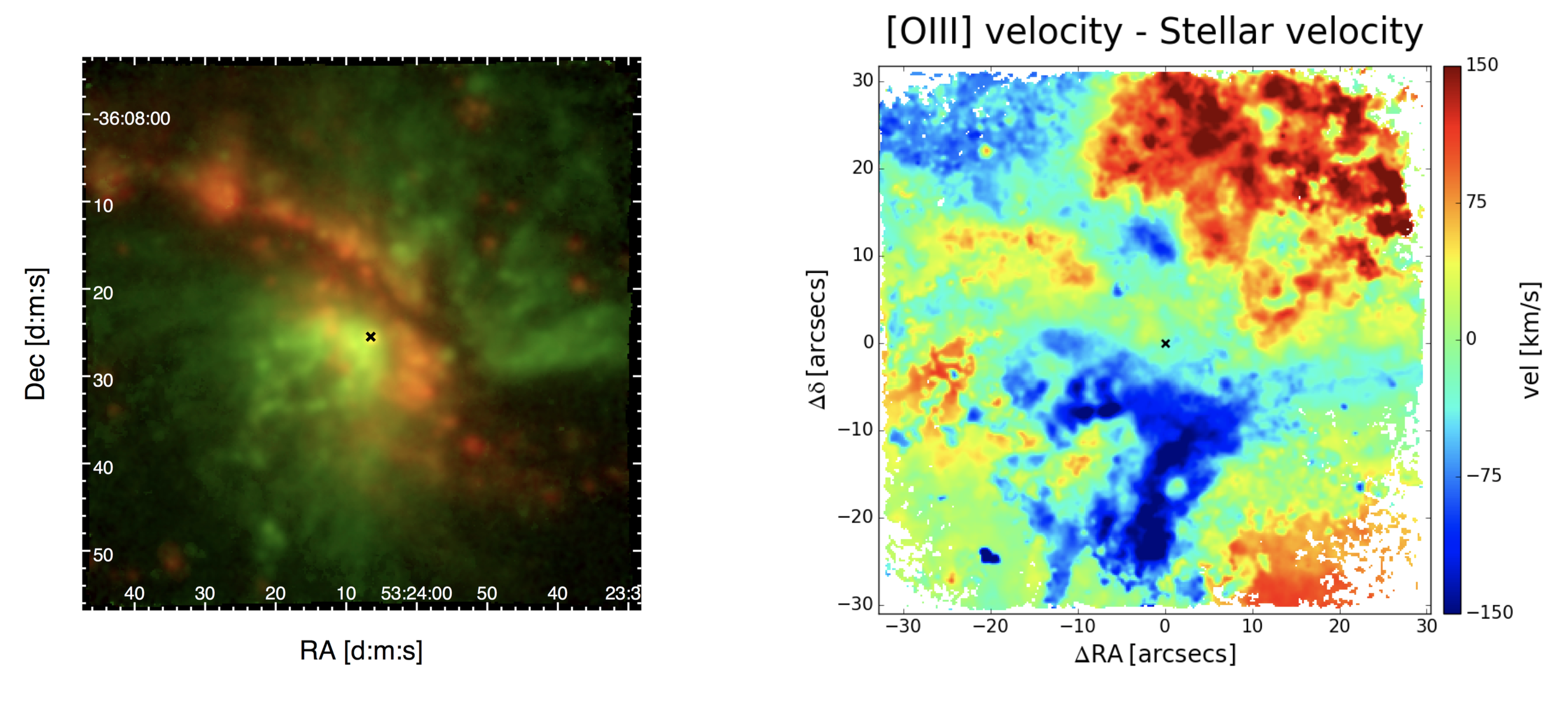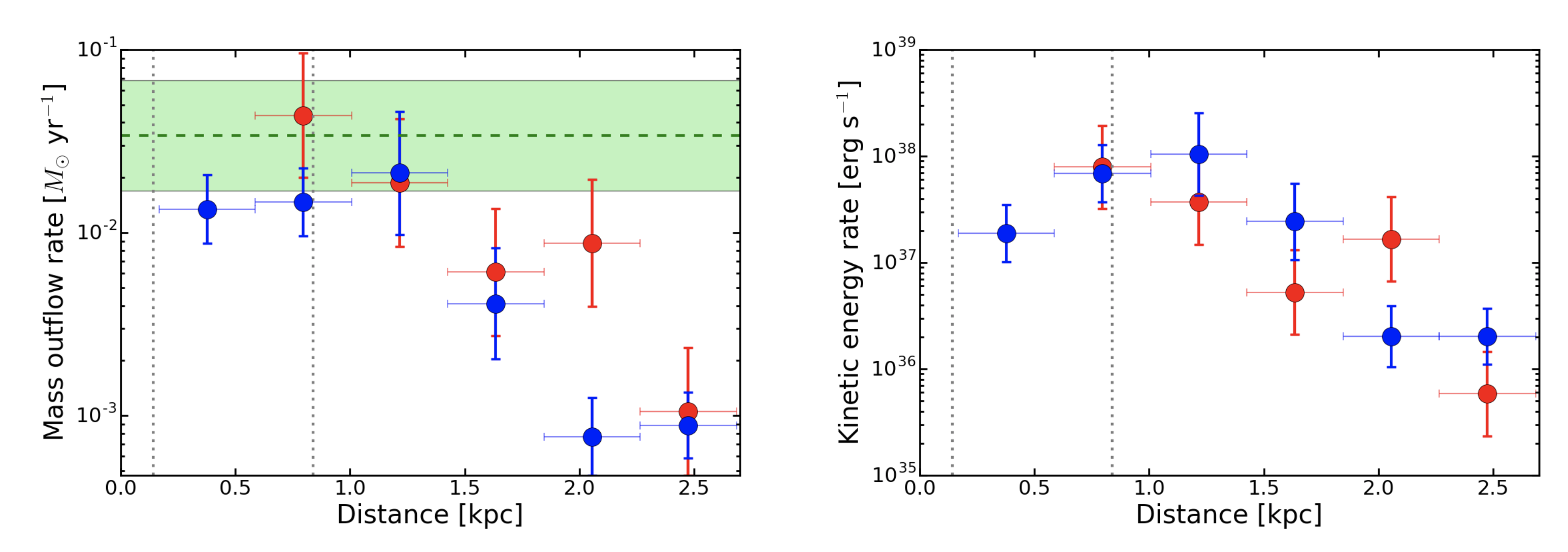An unprecedented view on ionized gas and outflows in the nearby active galaxy NGC 1365
All galaxies in the Universe are thought to host a supermassive black hole (BH) at their center. In some cases the BH can accrete large quantities of surrounding material and reprocess it in the form of energetic electromagnetic radiation, giving rise to a so-called active galactic nucleus (AGN), capable of accelerating fast winds and producing gas outflows. These outflows are believed to have an important role in shaping the formation and evolution of galaxies throughout the history of the Universe. Extended outflows of ionized gas are commonly observed in AGN but the low intrinsic spatial resolution of the observations has generally prevented a detailed characterization of their properties and impact on the host galaxies.
A team of astronomers from the Arcetri Astrophysical Observatory has started an observational campaign, called MAGNUM (Measuring Active Galactic Nuclei Under MUSE Microscope), to overcome these limitations by targeting the nearest galaxies hosting an AGN with the new-generation Multi Unit Spectroscopic Explorer (MUSE) at the Very Large Telescope (VLT) in Chile. MUSE provides a total of about 90000 spectra in the optical and near-infrared band on a wide area in the sky (1′⨉1′). This allowed the team to inspect the ionized gas in the central kiloparsecs of nearby active galaxies in unprecedented detail, resolving its structure and kinematics down to the scale of single gas clouds (about 10 parsec). The first results of the MAGNUM survey are published in a work led by G. Venturi in collaboration with E. Nardini as well as A. Marconi, M. Mingozzi, G. Cresci, F. Mannucci, G. Risaliti, A. Gallazzi, M. Perna, P. Tozzi and S. Zibetti from the Arcetri Astrophysical Observatory. The paper (Venturi et al. 2018) focuses on the barred spiral galaxy NGC 1365 hosting an AGN.
Among the various ionized gas emission lines observable within MUSE wavelength range, Hα allows to trace star formation in the galaxy, while [OIII] emission is sensitive to the ionization from AGN photons. Moreover, from the Doppler shift of the emission lines it is possible to infer the kinematics of the ionized gas. Fig. 1 (left panel) displays the distribution of the ionized gas emission in the central 5 kpc of NGC 1365 covered by MUSE. Star formation predominantly occurs in an S-shaped region along the bar and in a circumnuclear ring (red), while the gas ionized by the energetic radiation from the spatially-unresolved AGN located in the nucleus (at the position of the cross) is distributed in a perpendicular double cone (green). The kinematics of the ionized gas reveals a bipolar outflow in correspondence of the ionization cones, with velocities up to about 200 km/s (Fig. 1 right panel). The biconical outflow approaches the observer to the bottom-left of the nucleus (negative velocities), while it recedes to the top-right (positive velocities). The former resides in fact above the disk of the galaxy, while the latter behind it, partially obscured by dust in the disk, as shown by their different brightness in the left panel.
 |
| Figure 1: Ionized gas distribution and kinematics in the central 5 kpc of NGC 1365 obtained with MUSE at VLT. Left panel: Hα emission (red), tracing star formation in the galaxy, and [OIII] emission (green), due to the energetic ionizing radiation from the active galactic nucleus. Right panel: [OIII] velocity, revealing a biconical ionized outflow, approaching to the bottom-left (negative velocities), receding to the top-right (positive velocities). |
Comparison with data from the Chandra X-ray space telescope, tracing the hot diffuse gas emitting in X-rays (with a temperature of about 106-107 K), shows that the diffuse X-ray emission predominantly arises from star-forming regions. However, the authors were able to isolate the hot gas component ionized by the AGN and show that this nicely matches the optical counterpart from MUSE emitting in [OIII], given by warm ionized gas (with a temperature of about 104 K). Moreover, the presence of a nuclear spatially-unresolved wind of hot, highly-ionized gas is traced by absorption lines in the X-rays, indicating a velocity of about 3000 km/s for this nuclear wind.
The spatially-resolved information provided by MUSE allowed the team to investigate the properties of the extended ionized outflow as a function of distance from the AGN. In particular, the radial profiles of the mass outflow rate and of the kinetic energy rate, that is, the rate at which the mass of ionized gas participating in the outflow and its associated kinetic energy flow away from the nucleus, are displayed in Fig. 2. After an initial peak at a radius of about 1 kpc, the mass outflow rate and the kinetic energy rate drop at larger distances, implying either that the outflow slows down with radius or that the AGN activity has intensified recently. Finally, the mass outflow rate of the nuclear X-ray wind is consistent with that of the extended ionized outflow within 1 kpc, suggesting that the nuclear and galactic-scale outflows are only two different phases of the same wind accelerated by the AGN.
 |
| Figure 2: Radial profiles of the mass outflow rate (left panel) and kinetic energy rate (right panel) of the galactic ionized outflow as a function of distance from the active galactic nucleus. Blue and red points indicate the approaching and the receding cone, respectively (see right panel of Fig. 1). The green dashed line marks the mass outflow rate of the fast nuclear wind measured from X-rays. |
The results of this work are published in:
Venturi G. et al., ‘MAGNUM survey: A MUSE-Chandra resolved view on ionized outflows and photoionization in the Seyfert galaxy NGC1365’, 2018, A&A, 619, 74 (also available here)
Further MAGNUM publications on the topic:
Mingozzi M. et al., ‘The MAGNUM survey: different gas properties in the outflowing and disk components in nearby active galaxies with MUSE’, A&A, accepted (available here)
Venturi G. et al., 'Ionized gas outflows from the MAGNUM survey: NGC 1365 and NGC 4945’, 2017, FrASS, 4, 46 (also available here)
Edited by G. Venturi and A. Gallazzi



